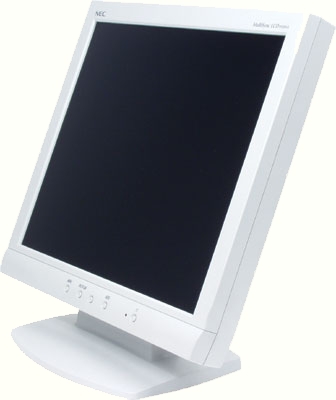Affordable 19" LCD Monitors
Nec LCD1920NX
Nec having wrongly decided that the market was not ripe for big screens, they were forced to bring out a low-priced basic 19" without much background research so as not to be left out of the race. The result is the 1920NX, a cream-colored monitor with no height adjustment, a coarse figure, and generally unpleasing looks. It does have two good points though: the viewing angle is very good and it has two inputs - DVI and D-Sub. An unfortunate failing is that it has an external transformer.
The OSD is no better. No help is provided, so you have to work blindfolded. The best calibration results we got were with contrast and quality of 24 little white bars out of the 30 available. It's up to you to count them: no numerical value like a percentage of the total value or even any hint at all is given. The same goes for the colors where in the end we chose the setting Preset 1.
Colors
On the right there is a button called ECO. Pressing it several times takes you through the high, middle, low, and USER modes. We found that Middle gives a brightness of about 100cd/m², not unlike on a CRT, and Hi gives 150cd/m². But whatever setting you choose, this screen is not as bright as the others, which are mostly around 200cd/m².
For our adjustments, we set the OSD at 6500K with Gamma 2. We tested the Middle, Hi and USER settings of the ECO button. The best results were obtained at ECO = Middle.
6500K
The profile can be downloaded below. Install it in C:\WINDOWS\system32\spool\drivers\color. Then you activate it by going to advanced display properties, then Color Management. Add the profile and select it as default.
Get Tom's Hardware's best news and in-depth reviews, straight to your inbox.
The result is fairly good. 92% of the colors (DeltaE <2) were adequately displayed. 82% (DeltaE <1) of them were perfectly displayed. Only the 5% darkest ones (DeltaE >3) came out poorly, and in fact they are impossible to display on this monitor.
It doesn't show in this graph, but one of the good things about this monitor is that it does not display an unreadable dark area where its panel cannot reproduce any colors. It climbs gradually up the grays and does really display 256 separate colors. The white is not exactly white and the black not black, but no matter, as shading is gradual and has no breaks.
While it may not be bad, we can't help noticing that the definite quality gain on the last 17" monitors we tested is harder to achieve on the 19" ones, which are one or two years behind. The game tests also confirmed this.


